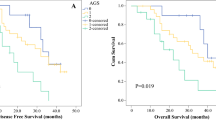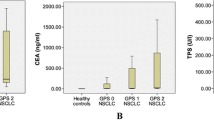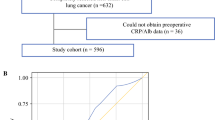Abstract
The association of the percentage composition of serum protein in patients undergoing lung resections for non-small cell lung cancer (NSCLC) with overall survival and recurrence-free survival has never been investigated. Patients were selected consecutively from the database of the Bio-Bank of Shandong Provincial Hospital. We retrospectively examined the impact of preoperative percentage composition of serum protein detected by serum protein electrophoresis on survival. Furthermore, we investigated the relationships between the potential prognostic biomarkers and clinicopathological factors. A total of 390 patients were evaluated. The higher percentage of α1-globulin in serum protein was significantly associated with histology type (p < 0.001), worse tumor status (p < 0.001) and higher pathological stage (p = 0.004). The α1-globulin percentage composition was an independent prognostic factor for overall survival (hazard ratio 1.52, 95 % CI 1.04–2.23, p = 0.03). High percentage of α1-globulin in serum protein was also related to short recurrence survival (hazard ratio 1.56, 95 % CI 1.14–2.13, p = 0.005). Our results showed that the percentage of α1-globulin in serum protein may be an independent prognostic factor in NSCLC.


Similar content being viewed by others
References
Siegel R, Naishadham D, Jemal A. Cancer statistics, 2013. Cancer J Clin. 2013;63(1):11–30.
Jemal A, Bray F, Center MM, Ferlay J, Ward E, Forman D. Global cancer statistics. Cancer J Clin. 2011;61(2):69–90. doi:10.3322/caac.20107.
Shio Y, Suzuki H, Kawaguchi T, Ohsugi J, Higuchi M, Fujiu K, et al. Carbohydrate status detecting by PNA is changeable through cancer prognosis from primary to metastatic nodal site: a possible prognostic factor in patient with node-positive lung adenocarcinoma. Lung Cancer. 2007;57(2):187–92. doi:10.1016/j.lungcan.2007.02.007.
Diab SG, Clark GM, Osborne CK, Libby A, Allred DC, Elledge RM. Tumor characteristics and clinical outcome of tubular and mucinous breast carcinomas. J Clin Oncol. 1999;17(5):1442–8.
Okada M, Nishio W, Sakamoto T, Uchino K, Yuki T, Nakagawa A, et al. Effect of tumor size on prognosis in patients with non-small cell lung cancer: the role of segmentectomy as a type of lesser resection. J Thorac Cardiovasc Surg. 2005;129(1):87–93. doi:10.1016/j.jtcvs.2004.04.030.
Remiszewski P, Roszkowski-Sliz K, Wiatr E, Roszkowska-Sliz B, Zych J, Kurzyna M, et al. Prognosis in limited disease (LD) small cell lung cancer (SCLC) patients according to status performance, local extension of lesions, type of treatment and the completeness of staging. Pneumonol Alergol Pol. 2003;71(3–4):139–47.
Sheng L, Luo M, Sun X, Lin N, Mao W, Su D. Serum fibrinogen is an independent prognostic factor in operable nonsmall cell lung cancer. Int J Cancer. 2013;133(11):2720–5.
Salmeron D, Chirlaque MD, Isabel Izarzugaza M, Sanchez MJ, Marcos-Gragera R, Ardanaz E, et al. Lung cancer prognosis in Spain: the role of histology, age and sex. Respir Med. 2012;106(9):1301–8. doi:10.1016/j.rmed.2012.06.006.
Rabinovitz M, Gavaler JS, Kelly RH, Prieto M, Van Thiel DH. Lack of increase in heterozygous alpha 1-antitrypsin deficiency phenotypes among patients with hepatocellular and bile duct carcinoma. Hepatology. 1992;15(3):407–10.
Pelliniemi TT, Irjala K, Mattila K, Pulkki K, Rajamaki A, Tienhaara A, et al. Immunoreactive interleukin-6 and acute phase proteins as prognostic factors in multiple myeloma. Finnish Leukemia Group. Blood. 1995;85(3):765–71.
Li Y, Krowka MJ, Qi Y, Katzmann JA, Song Y, Li Y, et al. Alpha1-antitrypsin deficiency carriers, serum alpha 1-antitrypsin concentration, and non-small cell lung cancer survival. J Thorac Oncol. 2011;6(2):291–5. doi:10.1097/JTO.0b013e31820213fb.
El-Akawi ZJ, Abu-Awad AM, Sharara AM, Khader Y. The importance of alpha-1 antitrypsin (alpha1-AT) and neopterin serum levels in the evaluation of non-small cell lung and prostate cancer patients. Neuro Endocrinol Lett. 2010;31(1):113–6.
O’Connell TX, Horita TJ, Kasravi B. Understanding and interpreting serum protein electrophoresis. Am Fam Physician. 2005;71(1):105–12.
Vavricka SR, Burri E, Beglinger C, Degen L, Manz M. Serum protein electrophoresis: an underused but very useful test. Digestion. 2009;79(4):203–10. doi:10.1159/000212077.
Travis WD, Brambilla E, Noguchi M, Nicholson AG, Geisinger KR, Yatabe Y, et al. International association for the study of lung cancer/american thoracic society/european respiratory society international multidisciplinary classification of lung adenocarcinoma. J Thorac Oncol. 2011;6(2):244–85.
Goldstraw P, Crowley J, Chansky K, Giroux DJ, Groome PA, Rami-Porta R, et al. The IASLC Lung Cancer Staging Project: proposals for the revision of the TNM stage groupings in the forthcoming (seventh) edition of the TNM classification of malignant tumours. J Thorac Oncol. 2007;2(8):706–14.
Van der Schouw YT, Verbeek AL, Ruijs JH. ROC curves for the initial assessment of new diagnostic tests. Fam Pract. 1992;9(4):506–11.
Metz CE. Basic principles of ROC analysis. Semin Nucl Med. 1978;8(4):283–98.
Bata J, Colobert L, Biron A, Brune J. Study of various serum proteins in lung cancer. Immunoglobulins A, G, M, haptoglobin, alpha-1-antitrypsin, alpha-2-macroglobulin. Ann Biol Clin (Paris). 1977;35(4):297–303.
Krecicki T, Leluk M. Acute phase reactant proteins—an aid to monitoring surgical treatment of laryngeal carcinoma. J Laryngol Otol. 1992;106(7):613–5.
Amiguet JA, Jimenez J, Monreal JI, Hernandez MJ, Lopez-Vivanco G, Vidan JR, et al. Serum proteolytic activities and antiproteases in human colorectal carcinoma. J Physiol Biochem. 1998;54(1):9–13.
Coakley RJ, Taggart C, O’Neill S, McElvaney NG. Alpha1-antitrypsin deficiency: biological answers to clinical questions. Am J Med Sci. 2001;321(1):33–41.
Perlmutter DH. Liver injury in alpha1-antitrypsin deficiency: an aggregated protein induces mitochondrial injury. J Clin Invest. 2002;110(11):1579–83. doi:10.1172/jci16787.
Luft FC. Alpha-1-antitrypsin and its relevance to human disease. J Mol Med (Berl). 1999;77(4):359–60.
Faust D, Raschke K, Hormann S, Milovic V, Stein J. Regulation of alpha1-proteinase inhibitor release by proinflammatory cytokines in human intestinal epithelial cells. Clin Exp Immunol. 2002;128(2):279–84.
Cichy J, Potempa J, Travis J. Biosynthesis of alpha1-proteinase inhibitor by human lung-derived epithelial cells. J Biol Chem. 1997;272(13):8250–5.
Ades EW, Hinson A, Chapuis-Cellier C, Arnaud P. Modulation of the immune response by plasma protease inhibitors. I. Alpha 2-macroglobulin and alpha 1-antitrypsin inhibit natural killing and antibody-dependent cell-mediated cytotoxicity. Scand J Immunol. 1982;15(1):109–13.
Higashiyama M, Doi O, Kodama K, Yokouchi H, Tateishi R. An evaluation of the prognostic significance of alpha-1-antitrypsin expression in adenocarcinomas of the lung: an immunohistochemical analysis. Br J Cancer. 1992;65(2):300–2.
Kataoka H, Uchino H, Iwamura T, Seiki M, Nabeshima K, Koono M. Enhanced tumor growth and invasiveness in vivo by a carboxyl-terminal fragment of alpha1-proteinase inhibitor generated by matrix metalloproteinases: a possible modulatory role in natural killer cytotoxicity. Am J Pathol. 1999;154(2):457–68.
Shoenfeld Y, Fishman P. Gamma-globulin inhibits tumor spread in mice. Int Immunol. 1999;11(8):1247–52.
Muers MF, Shevlin P, Brown J. Prognosis in lung cancer: physicians’ opinions compared with outcome and a predictive model. Thorax. 1996;51(9):894–902.
Kobayashi N, Usui S, Kikuchi S, Goto Y, Sakai M, Onizuka M, et al. Preoperative lymphocyte count is an independent prognostic factor in node-negative non-small cell lung cancer. Lung Cancer. 2012;75(2):223–7. doi:10.1016/j.lungcan.2011.06.009.
Zhao W, Yang Z, Liu X, Tian Q, Lv Y, Liang Y, et al. Identification of alpha1-antitrypsin as a potential prognostic biomarker for advanced nonsmall cell lung cancer treated with epidermal growth factor receptor tyrosine kinase inhibitors by proteomic analysis. J Int Med Res. 2013;41(3):573–83. doi:10.1177/0300060513476582.
Acknowledgments
The authors thank all the patients and investigators involved in the study. The work was supported by Promotive research fund for young and middle-aged scientists of Shandong Province (BS2013YY066).
Conflict of interest
The authors have no conflicts of interest to declare.
Author information
Authors and Affiliations
Corresponding authors
Additional information
Xiao Qu, Zhaofei Pang and Weiwei Yi have contributed equally to this work.
Rights and permissions
About this article
Cite this article
Qu, X., Pang, Z., Yi, W. et al. High percentage of α1-globulin in serum protein is associated with unfavorable prognosis in non-small cell lung cancer. Med Oncol 31, 238 (2014). https://doi.org/10.1007/s12032-014-0238-7
Received:
Accepted:
Published:
DOI: https://doi.org/10.1007/s12032-014-0238-7




